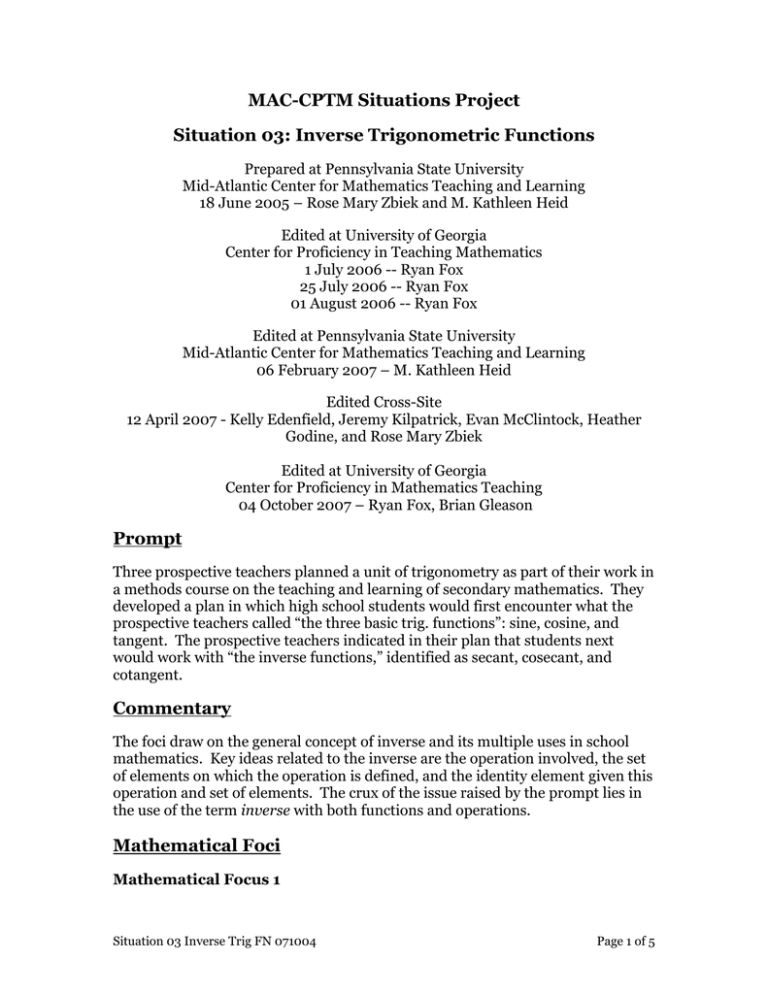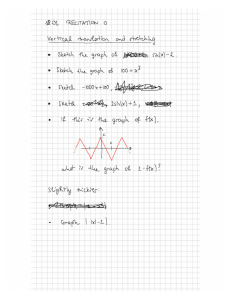MAC-CPTM Situations Project Situation 03: Inverse Trigonometric Functions
advertisement

MAC-CPTM Situations Project Situation 03: Inverse Trigonometric Functions Prepared at Pennsylvania State University Mid-Atlantic Center for Mathematics Teaching and Learning 18 June 2005 – Rose Mary Zbiek and M. Kathleen Heid Edited at University of Georgia Center for Proficiency in Teaching Mathematics 1 July 2006 -- Ryan Fox 25 July 2006 -- Ryan Fox 01 August 2006 -- Ryan Fox Edited at Pennsylvania State University Mid-Atlantic Center for Mathematics Teaching and Learning 06 February 2007 – M. Kathleen Heid Edited Cross-Site 12 April 2007 - Kelly Edenfield, Jeremy Kilpatrick, Evan McClintock, Heather Godine, and Rose Mary Zbiek Edited at University of Georgia Center for Proficiency in Mathematics Teaching 04 October 2007 – Ryan Fox, Brian Gleason Prompt Three prospective teachers planned a unit of trigonometry as part of their work in a methods course on the teaching and learning of secondary mathematics. They developed a plan in which high school students would first encounter what the prospective teachers called “the three basic trig. functions”: sine, cosine, and tangent. The prospective teachers indicated in their plan that students next would work with “the inverse functions,” identified as secant, cosecant, and cotangent. Commentary The foci draw on the general concept of inverse and its multiple uses in school mathematics. Key ideas related to the inverse are the operation involved, the set of elements on which the operation is defined, and the identity element given this operation and set of elements. The crux of the issue raised by the prompt lies in the use of the term inverse with both functions and operations. Mathematical Foci Mathematical Focus 1 Situation 03 Inverse Trig FN 071004 Page 1 of 5 An inverse requires three entities: a set with a binary operation, and an identity element given this operation and set of elements. Secondary mathematics involves work with many different contexts for inverses. For example, opposites are additive inverses defined for real numbers and with additive identity of 0, and reciprocals are multiplicative inverses defined for nonzero real numbers and with multiplicative identity of 1. In general, if * is the binary operation, S is the set of elements on which * is defined, e S, and e is the identity element, then for c, d S, c is an inverse of d in the system if and only if c*d = d*c = e. For functions, including trigonometric functions, the set is often assumed to be functions (or some subset of ), the operation is composition of functions, and the identity is given by f(x) = x. If a function g is the inverse of the sine function, for example, then g(sin(x)) = sin(g(x)) = x. An observation such as csc(sin(0)) ≠ 0 is sufficient to show that csc(x) is not an inverse function under composition for sin(x). If the operation is multiplication and the set is real numbers, in contrast, the multiplicative identity is 1, and for any value of x such that sin(x) ≠ 0, the number csc(x) is the multiplicative inverse for the number sin(x). More generally, the functions f : S T and g : T S are inverses if and only if g consists of the ordered pairs (f(s), s) and f consists of the ordered pairs (g(t), t). Support for that conclusion comes from consideration of issues of domain and range. In order for f and g to be inverse functions, f g t t and g f s s . Note that in this case, the identity ‘entity’ actually consists of an identity function on T and an identity function on S. When the domain and range are copies of the same set, the two identities will be equivalent. For the functions f and g above, the range of f must be the domain of g, and the range of g must be the domain of f. For example, the domain of sine is the set of all real numbers, but because the range of cosecant is not all real numbers, cosecant and sine are not inverse functions. Mathematical Focus 2 Although the inverse under multiplication is not the same as the inverse under function composition, the same notation, the superscript -1, is used for both. The general function notation, y = f(x), means that y is the image of x under the function f. To indicate the inverse function, the notation x = f-1(y) is used; it means that x is the image of y under the inverse of f. The superscript -1 is used to show that the inverse f-1 is a function related to f; the superscript is not to be interpreted as an exponent. In contrast, z xy means that z is the product of x and y, and to indicate the inverse of the product, the notation x = zy-1 is used, where the superscript is interpreted as an exponent. These two usages of the superscript -1 are distinct in that one represents a function inverse and the other Situation 03 Inverse Trig FN 071004 Page 2 of 5 is usually thought of as an exponent that happens to yield the multiplicative inverse. The functions secant, cosecant, and cotangent are defined, respectively, as 1 1 1 follows: sec( x ) , csc( x ) , and cot( x ) . They are not defined sin( x ) tan( x ) cos( x ) for cos (x) = 0, sin (x) = 0, or tan (x) = 0. They are written using exponents as sec (x) (cos (x))-1, csc (x) (sin (x))-1, and cot (x) (tan (x))-1. In contrast, the inverse functions of sine, cosine, and tangent are, respectively, sin 1 ( x ) (sometimes written arcsin (x)), cos1 ( x) (sometimes written arccos (x)), and tan 1 ( x ) (sometimes written arctan (x) or arctg (x)). These inverse trigonometric functions are multi-valued in the sense that there are multiple values of x such that y = sin (x), so sin 1 ( x ) is not uniquely defined and is therefore not a function unless a principal value is defined by restricting the domain of y = sin (x). Restricting y = sin (x) to x with 1 y 1 yields 2 2 an inverse sine function with 1 x 1 and y . Principal values are 2 2 principal value of the sometimes denoted with a capital letter; for example, the 1 1 inverse sine, sin ( x ) , may be denoted Sin ( x ) or Arcsin (x) (but this is far from universal and may, in fact, be used with the capitalization notation opposite meaning). Mathematical Focus 3 When functions are graphed in an xy-coordinate system with y as a function of x, these graphs are reflections of their inverses’ graphs (under composition) in the line y = x. The graph of a function reflected in the line y = x is the graph of its inverse function, though without restricting to principal values, the inverse may not be a function. Justifying this claim requires establishing that the reflection of an arbitrary point (a, b) in the line y = x is the point (b, a). The following argument shows that the reflection of an arbitrary point (a, b) in the line y = x is the point (b, a), using the geometric properties of reflection (the point Ais a reflection of the point A in line l if and only if l is the perpendicular bisector of AA' ). First, we note that the perpendicular bisector of AA' consists of precisely those points in the plane that are equidistant from A and A ' . So, we on the line y x , say c, c . Using the distance formula choose an arbitrary point to compute the distance between a, b and c, c and between b, a and c, c we find that c a 2 c b 2 Situation 03 Inverse Trig FN 071004 c b 2 c a and so the line y x is the 2 Page 3 of 5 perpendicular bisector of the line segment between a, b and b, a . Therefore, the reflection of the point a, b in the line y x is b, a . Suppose that cosecant and sine were inverse functions. Then, a reflection of the graph of y = csc(x) in the line y = x would be the graph of y = sin(x). The figure at the right shows, on one coordinate system, graphs of the sine function, the line given by y = x, the cosecant function, and the reflection of the cosecant function in the line y = x. Because the reflection of the graph of the cosecant function in the line y = x does not coincide with the graph of the sine function, sine and cosecant are not inverse functions. Post-Commentary When the trigonometric functions are defined in terms of the ratios of the sides of a right triangle, the three sides of the triangle give rise to six ratios. Because calculation with the ratios was so difficult in the days before calculators, names were given to each one and tables constructed for them. The advent of computers has meant that given one of the functions, the others are easily calculated using trigonometric identities. The secant, cosecant, and cotangent, which were never used much in applications, have consequently diminished somewhat in importance relative to the other three. The inverse trigonometric functions—especially the inverse sine, inverse tangent, and inverse secant—turn out to be useful in calculus as anti-derivatives for integrals involving quotients and non-integer powers of polynomials. They are often used in pre-calculus courses primarily to illustrate the concept of inverse function. There are several other methods for proving that the line y x is the perpendicular bisector of the line segment between a, b and b, a . One alternative is to find the midpoint of the line segment between a, b and b, a , see that it is on the line y x , and then compute the slope of the line segment between a, b and b, a to see that it is the negative (opposite) reciprocal of the slope of the line y x . Another alternative is to use a diagram similar to the one shown here to construct an argument involving congruent triangles. Some texts use both the term ‘range of a function’ and the term ‘image of a function’. Thus, these texts would say that the range of f x sin( x) is , while Situation 03 Inverse Trig FN 071004 Page 4 of 5 the image is the interval 1 f x 1 . Here, we take range to be the actual set of values the function evaluates to, and not any larger set that contains those values. Situation 03 Inverse Trig FN 071004 Page 5 of 5






